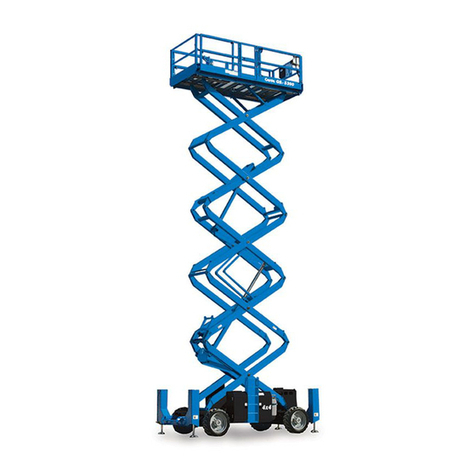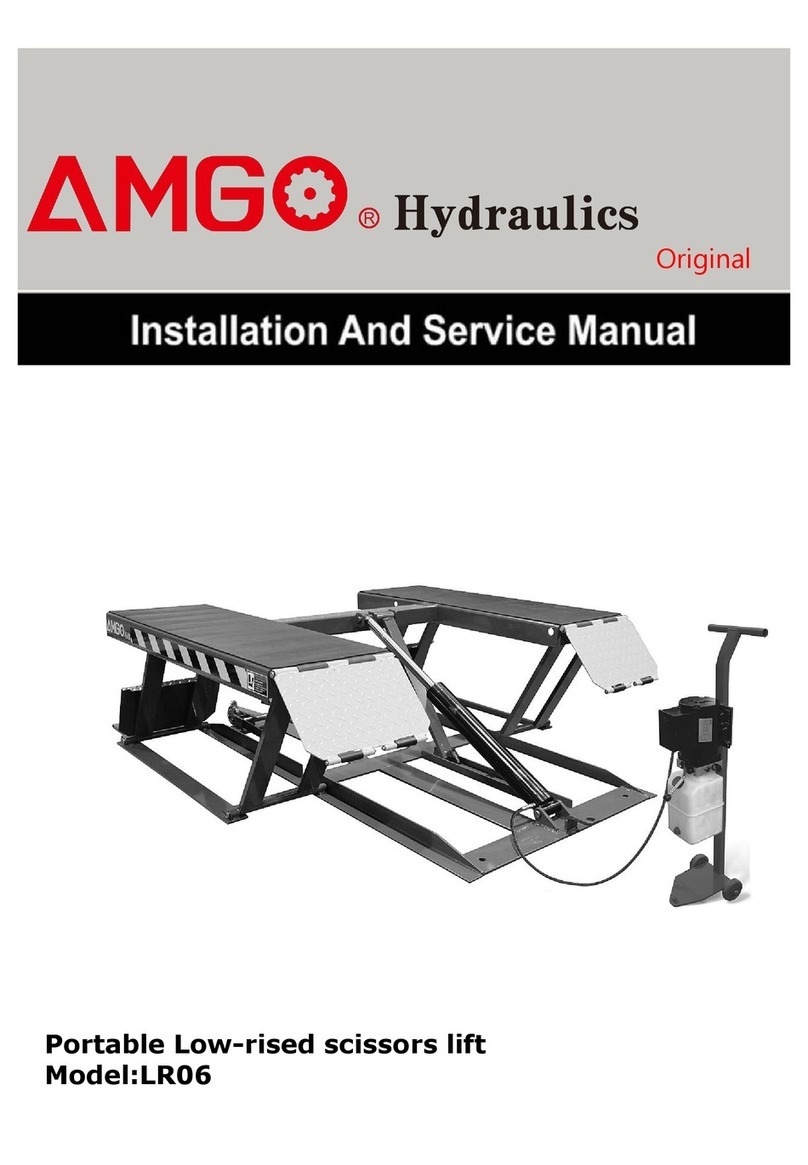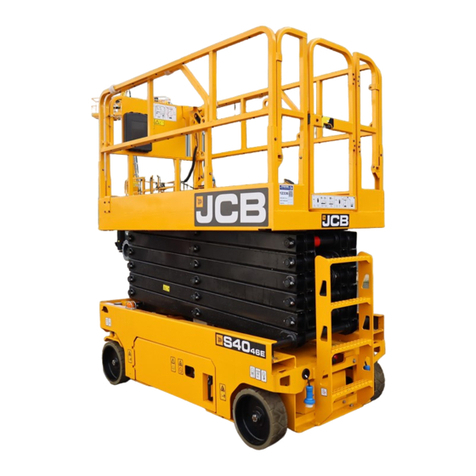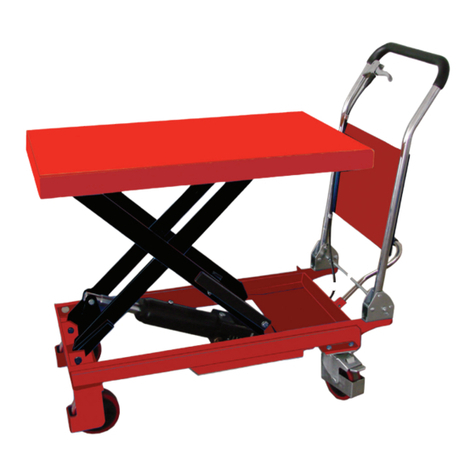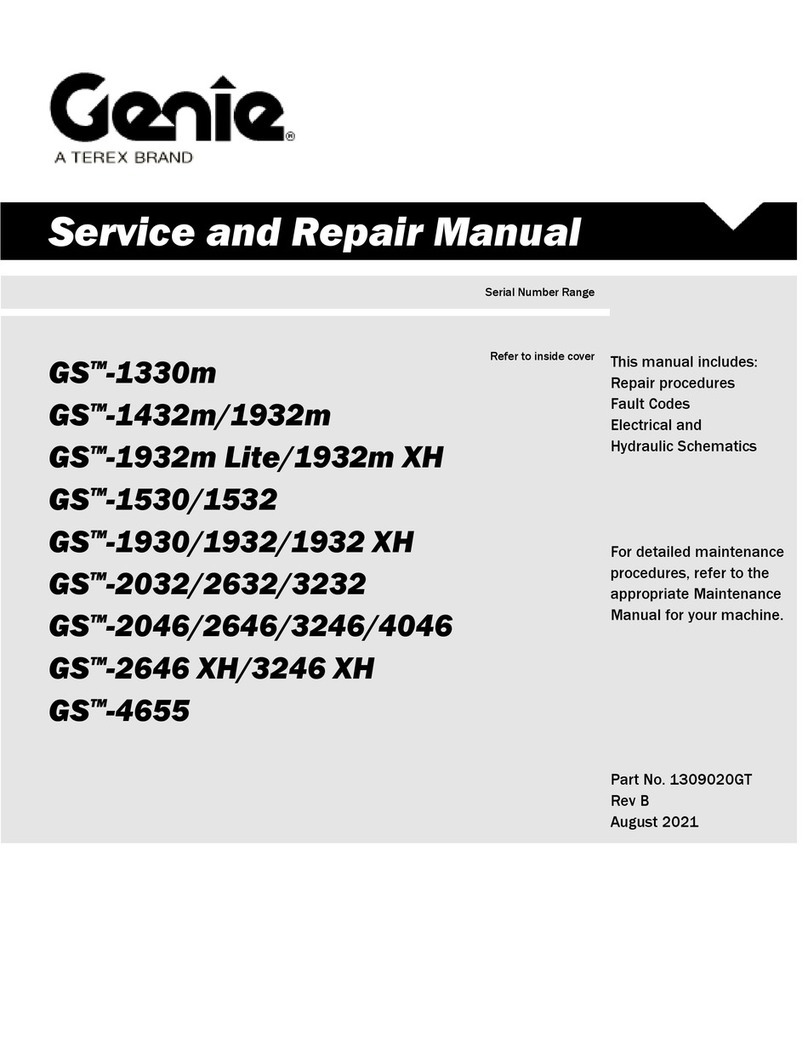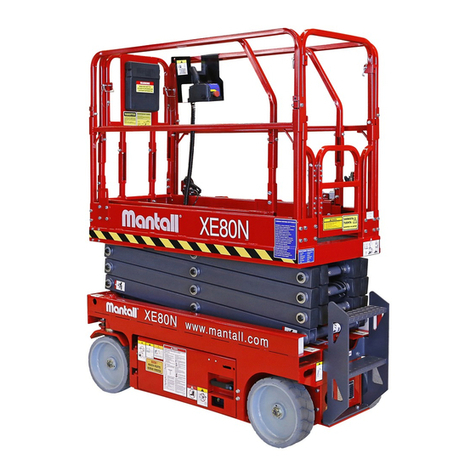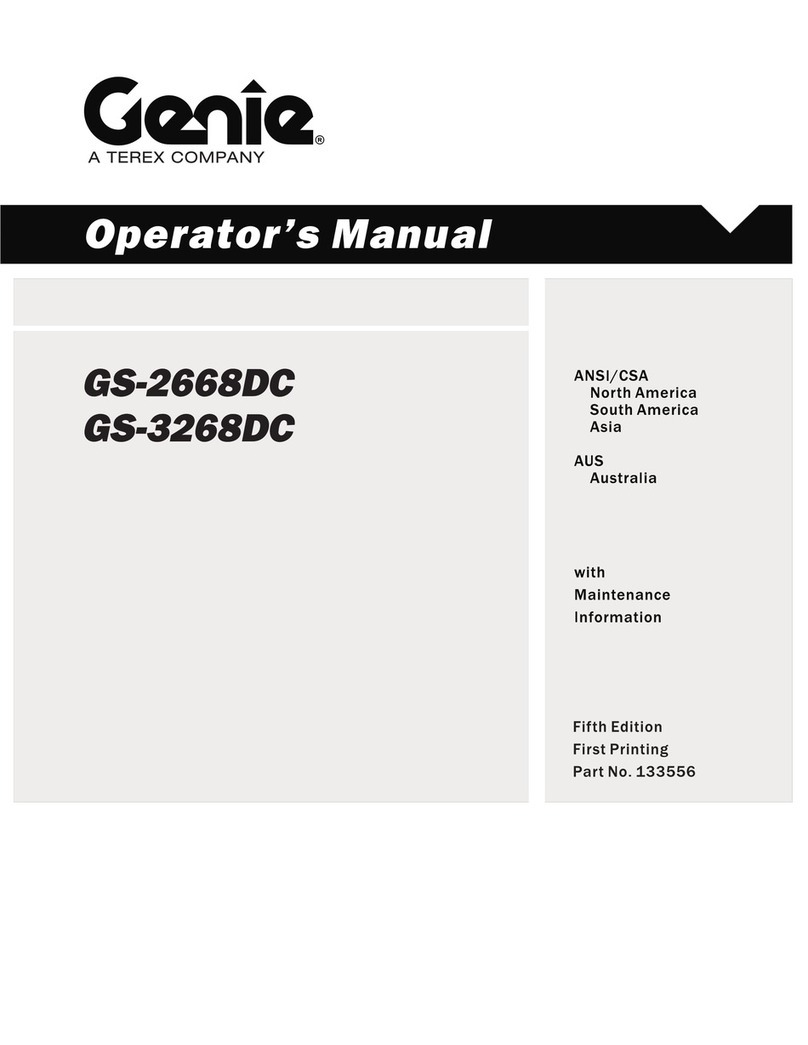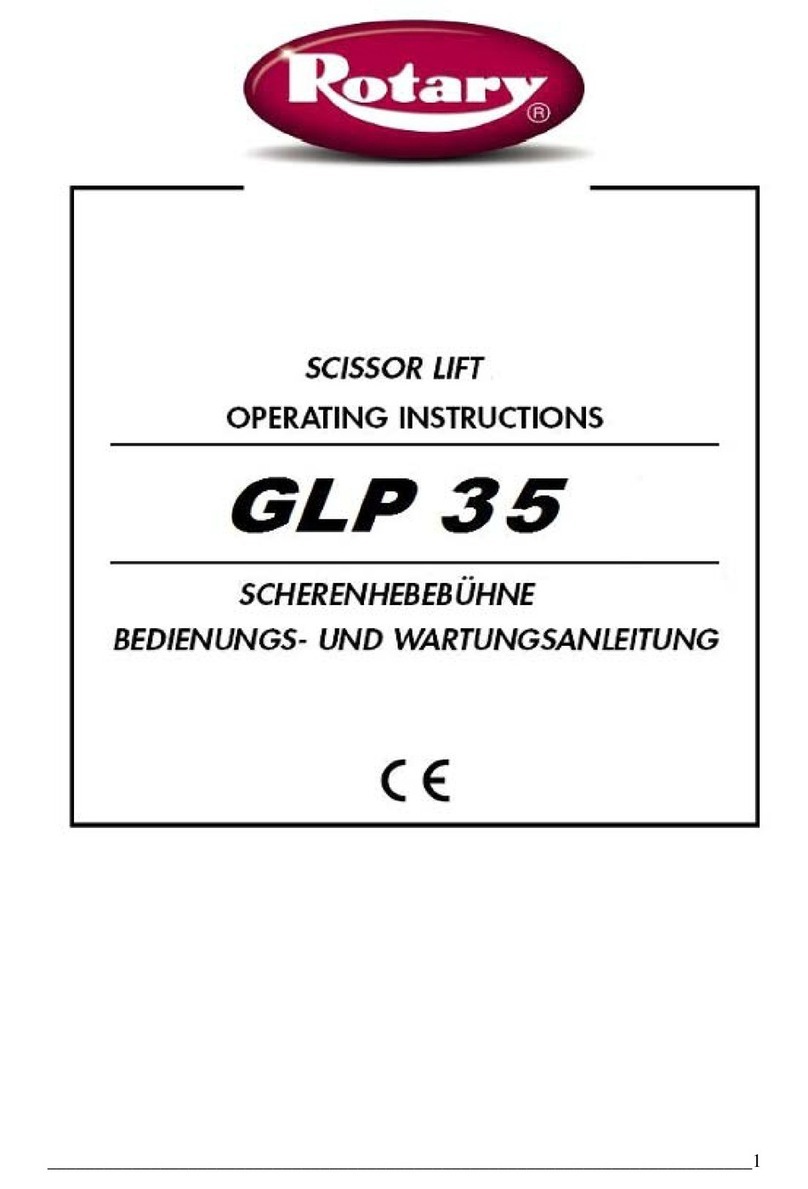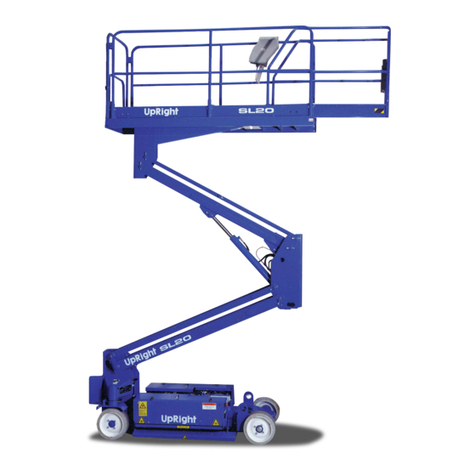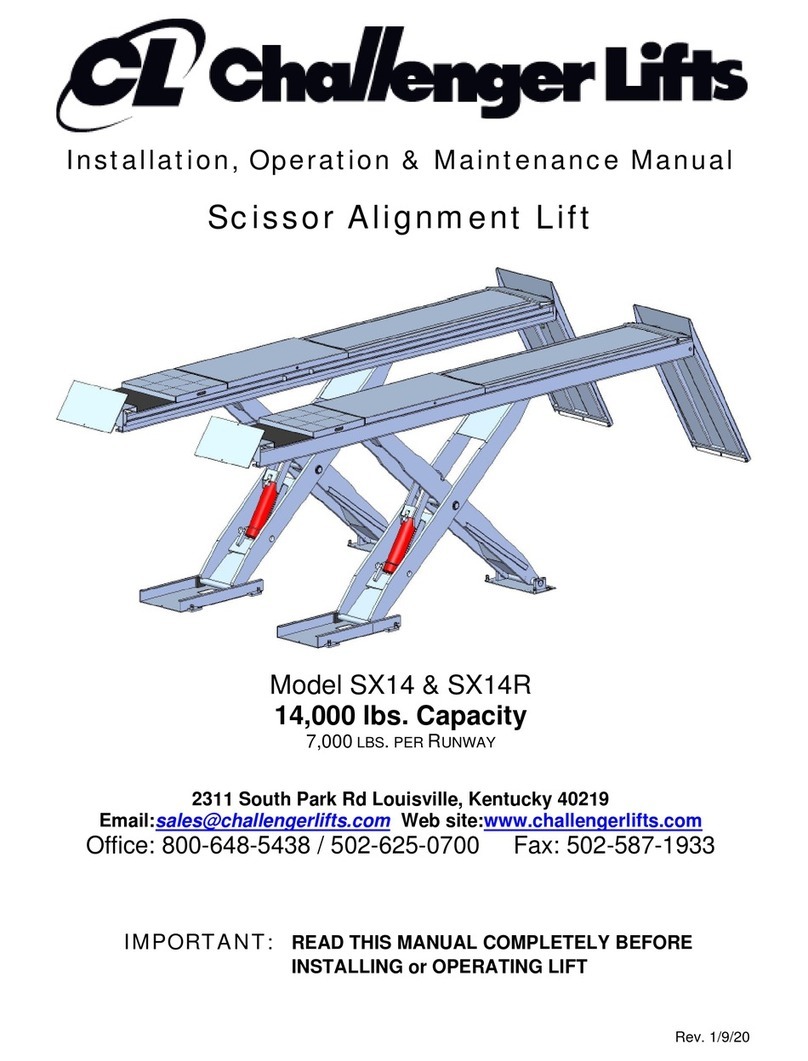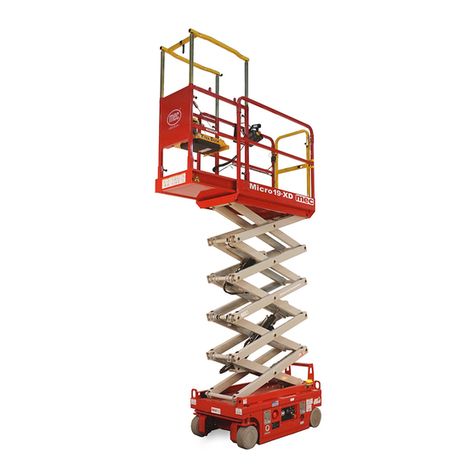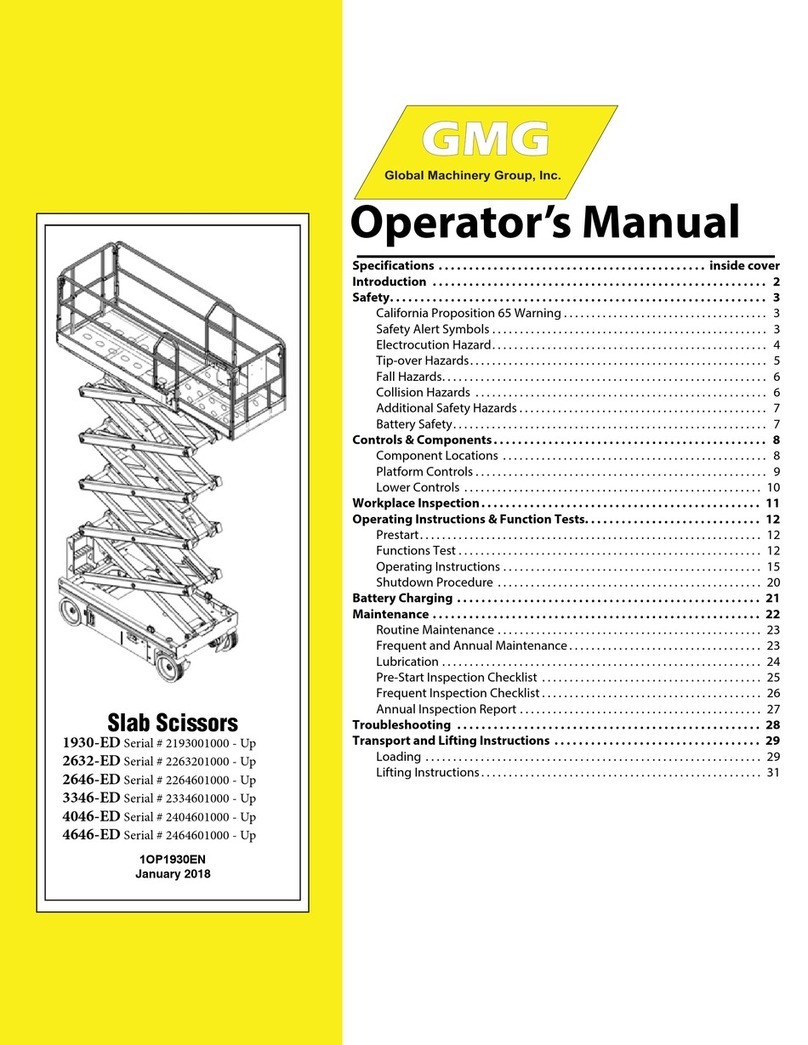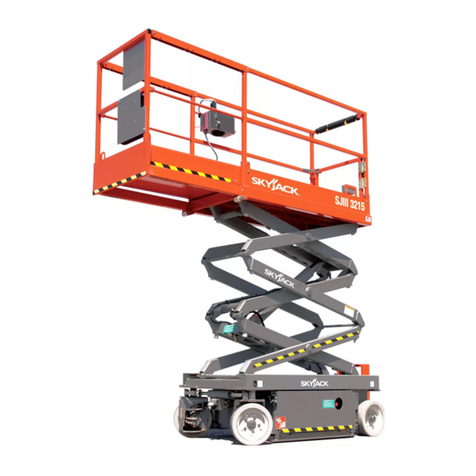WERTHER INTERNATIONAL SATURNUS EV45 Instructions for use

I
GB
F
D
E
PONTE SOLLEVATORE A FORBICE
SCISSORS LIFT
PONT ÉLÉVATEUR A CISEAUX
ELEKTROHYDRAULISCHE SCHERENHEBEBÜHNE
ELEVADOR DE TIJERAS
SATURNUSEV45
Werther 1-38,64-65,39-53,67-122,62-63,123 ITALGARAGE
Rema Tip-Top:
C/15


1
Manuale di istruzioni per l’uso e la manutenzione del
Instructions and maintenance manual for
Manuel d’instructions pour l’utilisation et l’entretien du:
Bedienungs- und Wartungsanleitung für
Manual de instrucciones para uso y mantenimiento de los
SOLLEVATORE PER AUTOVETTURE
SCISSORS VEHICLES LIFT
ELÉVATEURS POUR AUTOMOBILES
ELEKTROHYDRAULISCHE SCHERENHEBEBÜHNE
ELEVADOR PARA AUTOMÓVILES
Modello - Model - Modell - Modèle - Modelos
SATURNUS EV45
COSTRUTTORE: - MANUFACTURER: - HERSTELLER: - CONSTRUCTEUR: - FABRICANTE:
WERTHER INTERNATIONAL S.p.A.
Via F. BRUNELLESCHI, 12
42124 CADE’ (RE) - ITALY
Telefono +39 / 0522 / 9431 (r.a.) - Telefax +39 / 0522 / 941997
1aEmissione - 11/03/2014 - 1st Edition - 11/03/2014
1aÉdition - 11/03/2014 - 1. Ausgabe - 11/03/2014- 1ª Edición – 11/03/2014
CENTRO DI ASSISTENZA AUTORIZZATO:
AUTHORISED SERVICE CENTRE:
SERVICE APRÈS-VENTE AGRÉÉ:
KUNDENDIENSTCENTER
CENTRO DE ASISTENCIA AUTORIZADO:
Rev.3...................08/01/2015

Table des matières
Emballage, transport et stockage Page 04
Introduction Page 06
1 Description de L’appareil Page 08
2 Caractéristiques techniques Page 10
3 Sécurité Page 15
4 Installation Page 25
5 Fonctionnement Page 34
6 Contrôle périodique Page 41
7 Pannes et remèdes Page 44
Annexe A Informations particulieres Page 49
Annexe B Pièces de Rechange Page 51
Déclaration de Conformité
Indice
Imballaggio, trasporto e stoccaggio Pag.03
Introduzione Pag.05
1 Descrizione della macchina Pag.07
2 Specifiche tecniche Pag.09
3 Sicurezza Pag.15
4 Installazione Pag.24
5 Funzionamento e uso Pag.33
6 Controlli periodici Pag.40
7 Inconvenienti e rimedi Pag.43
Appendice A Informazioni particolari Pag.48
Appendice B Parti di ricambio Pag.50
Dichiarazioni di conformità
Inhaltsverzeichnis
Verpackung, Transport und Lagerung Seite 04
Einleitung Seite 06
1 Beschreibung der Hebebühne Seite 08
2 Technische Spezifikationen Seite 10
3 Sicherheit Seite 15
4 Installation Seite 25
5 Betrieb und Gebauch Seite 34
6 Regelmässige Kontrollen Seite 41
7 Störungen und Abhilfen Seite 44
Anhang A Besondere Informationen Seite 49
Anhang B Ersatzteilliste Seite 51
Konformitätserklärung
Contents
Packing, transport and storage Page 03
Introduction Page 05
1 Description of the machine Page 07
2 Technical specifications Page 09
3 Safety Page 15
4 Installation Page 24
5 Operation Page 33
6 Regular checks Page 40
7 Troubleshooting Page 43
Appendix A Special Info Page 48
Appendix B Spare parts Page 50
Declarations of Conformity
Indice
Embalaje, transporte y almacenaje Pág. 04
Introducción Pág. 06
1 - Descripción de la máquina Pág. 08
2 - Características técnicas Pág. 10
3 - Seguridad Pág. 15
4 - Instalación Pág. 25
5 - Funcionamiento Pág. 34
6 -Verificaciones periódicas Pág. 41
7 - Detección de fallas y remedio Pág. 44
Apéndice A -Informaciónes particulares Pág. 49
Apéndice B- Piezas de Recambio Pág. 51
Declaratión de Conformidad

Fig.1 Abb.1
N N+PG
AT AT+PG
LT LT+PG
ATLT 2000 Kg ATLT+PG 2090 Kg
Fig.2 Abb2
IMBALLAGGIO, TRASPORTO E STOCCAGGIO
LE OPERAZIONI DI IMBALLAGGIO, SOLLEVAMENTO,
MOVIMENTAZIONE, TRASPORTO E DISIMBALLO DEVONO
ESSERE AFFIDATE ESCLUSIVAMENTE A PERSONALE CHE SIA
ESPERTO IN TALI OPERAZIONI
IMBALLAGGIO (Fig. 1)
Il sollevatore nelle versioni standard, viene spedito già montato con i
seguenti pezzi:
N°2 basi e pedane (P1 - P2) chiuse una sull’altra;
N°1 centralina di comando;
N°1 scatola in cartone con kit tubi e raccordi per i collegamenti idraulici,
tamponi in gomma, e piedini di regolazione;
N°1 serie di fermaruote (per sollevatore installato incassato);
N°1 serie di rampe di salita/discesa ( per sollevatore installato a
pavimento).
TRASPORTO (Fig. 2)
L’ imballo può essere sollevato o spostato sia con carrelli elevatori che
con gru o carri ponte. L’eventuale imbracatura deve essere
accompagnata da una seconda persona al fine di evitare pericolose
oscillazioni del carico.Rispettare, infine, al momento dello scarico o del
carico della merce i propri punti di presa e i carichi come indicato in
figura.
IATTENZIONE
All’arrivo, verificare che la merce non abbia subito danni durante il
trasporto e che ci siano tutti i pezzi indicati nella lista di spedizio-
ne. Comunicare immediatamente all’ incaricato o al trasportatore
le eventuali mancanze o irregolarità e eventuali danni che il
sollevatore abbia subito durante il trasporto.2
PACKING, TRANSPORT AND STORAGE
ALL PACKING, LIFTING, HANDLING, TRANSPORT AND
UNPACKING OPERATIONS ARE TO BE PERFORMED
EXCLUSIVELY BY EXPERT PERSONNEL
PACKING (Fig. 1)
Standard versions of the lift are dispatched previously assembled and
equipped as follows:
No.2 bases and platforms (P1-P2), one closed onto the opther;
No.1 control box;
No.1 carton box with pipes and connections, rubber pads and adjusting
feet;
No.1 set of wheel-stops (for recessed version);
No.1 set of on/off ramps (for models installed on flor).
TRANSPORT (fig. 2)
Packing can be lifted or moved by lift trucks, cranes or bridge cranes. In
case of slinging, a second person must always take care of the load, in
order to avoid dangerous oscillations. Furthermore, during loading and
unloading operations goods must be handled as shown in the picture.
IWARNING
At the arrival of the goods, check for possible damage due to tran-
sport operations. Also verify that all items specified in the delivery
notes are included. In case of missing parts, possible defects or
damages due to transport, the person in charge or the carrier must
be immediately informed.
3
4850
1400
800

EMBALLAGE, TRANSPORT ET STOCKAGE
LES OPERATIONS D’EMBALLAGE, DE SOULEVEMENT, DE
DEPLACEMENT, DE TRANSPORT ET DE DEBALLAGE DOIVENT
ETRE EXCLUSIVEMENT CONFIEES A UN PERSONNEL
COMPETANT DANS CE TYPE D’OPERATIONS.
EMBALLAGE (Fig. 1)
En version standard, l’élévateur est expédié pré-assemblé et se
compose des éléments suivants:
2 plates-formes élévatrices assemblées (P1-P2) refermées et posées
l’une sur l’autre;
1 pupitre de commande;
1 carton contenant les tuyauteries et les raccords hydrauliques, les
tampons en caoutchouc et les pieds de réglage;
1 jeu de butées de roues (pour les ponts encastrés);
1 jeu de rampes d’accès (pour les ponts posés au sol).
TRANSPORT ( Fig. 2)
Le pont emballé peut être soulevé et déplacé soit avec un chariot
élévateur, soit à l’aide d’une grue ou d’un pont roulant.
Lorsque le pont est suspendu par des élingues, il est indispensable qu’il
soit accompagné par une seconde personne afin d’éviter que ne se
produise un balancement dangereux de la charge.
Lors des opérations de chargement ou de déchargement, il est impératif de
respecter les points de prise indiqués dans la figure ci-dessous.
IATTENTION
A l’arrivée, contrôler que la marchandise n’ait subi aucune détérioration
au cours du transport et que tous les éléments indiqués sur le
bordereau de colisage soient effectivement présents. Communiquer
immédiatement au transporteur tout manquant ou tout dommage
constaté sur l’élévateur.
VERPACKUNG, TRANSPORT UND LAGERUNG
ALLE VERPACKUNGS-, HEBE-, TRANSPORT UND
AUSPACKARBEITEN SIND NUR VON
AUSGEBILDETEMFACHPERSONAL, DAS KENNTNISSE DES LIFTS
UND DER BEDIENUNGSANWEISUNG BESITZT,
DURCHZUFÜHREN.
VERPACKUNG (Abb. 1)
Die Hebebühne in Standard-Ausführung wird bereits zusammengebaut
mit folgenden Teilen geliefert:
Nr. 2 Grundrahmen und Plattformen ( P1 - P2 ), aufeinander
geschlossen;
Nr. 1 Steuerzentrale;
Nr. 1 Karton mit Schläuchen und Fittings für die
Hydraulikanschlüsse,Gummipuffer und Einstellfüße;
Nr.1 Radsperren (für Einbau-Hebebühnen);
Nr.1 Serie Auf- und Abfahrtrampen (für auf dem Boden installierte
Hebebühnen).
TRANSPORT ( Fig. 2)
Die Verpackung kann mit Hilfe eines Gabelstaplers oder mit einem
Kran oder Laufkran gehoben und bewegt werden.
Beim Heben mit Gurtzeug muss immer eine zweite Person anwesend sein,
die aufzupassen hat, dass die gehobene Last nicht ins Schwingen gerät.
Beim Abladen oder Aufladen der Ware ist darauf zu achten, dass die
Hubmittel an den auf der Abbildung dargestellten Hubpunkten angelegt
werden.
IATTENTION
Bei der Ankunft der Maschine ist zu kontrollieren, dass diese keine
Transportschäden aufweist und dass alle in den Versandunterlagen
aufgeführten Teile vorhanden sind. Wenn Teile fehlen sollten oder
wenn Transportschäden festgestellt werden, ist der Beauftragte oder
der Spediteur umgehend diesbezüglich zu unterrichten.
EMBALAJE, TRANSPORTE Y ALMACENAJE
LAS OPERACIONES DE EMBALAJE, TRANSPORTE,
DESIMBALAJE DEBEN SER EFECTUADAS POR PERSONAL QUE
TENGA EXPERIENCIA EN DICHAS OPERACIONES Y QUE
CONOZCA BIEN EL ELEVADOR Y ESTE MANUAL.
EMBALAJE (fig.1)
El elevador en la versión standard, se suministra con los siguientes
componentes:
N° 2 bases y plataformas (P1 y P2) cerradas una sobre la otra;
N° 1 centralita de mandos;
N° 1 caja de cartón con el juego de tubos y racores ara la conexión
hidráulica, tacos de goma y pies de regulación;
N° 1 juego de para-ruedas en caso de elevador empotrado;
N° 1 juego de rampas de subida/descenso (en caso de que no se
quiera empotrar el elevador).
TRANSPORTE (fig.2)
El embalaje puede ser elevado y trasladado con camión de plataforma,
camión de grúa ó grúa de puente.
En caso de tirar con una estinga, una segunda persona debe cui-
dar siempre de la carga, para evitar oscilaciones peligrosas. Ade-
más, durante la carga y la descarga, el género debe manejarse
como muestra la figura.
IATENCIÓN
A la llegada del género, verifique los posibles daños producidos
durante el transporte. También verifique que todos los artículos
especificados en las notas de entrega estén incluidos. En caso de
pérdidas, posibles defectos o daños debidos al transporte, debe
informarse inmediatamente de ello al transportista, haciéndolo constar
en la nota de entrega.

INTRODUZIONE
IATTENZIONE
Questo manuale è stato scritto per il personale di officina addetto all’uso del sollevatore
(operatore) e per il tecnico addetto alla manutenzione ordinaria (manutentore), prima di
effettuare qualsiasi operazione sul sollevatore e/o sul suo imballaggio, leggere tutto il
manuale, poichè esso contiene informazioni importanti per:
·LA SICUREZZA DELLE PERSONE addette all’uso ed alla
manutenzione ordinaria,
·LA SICUREZZA DEL SOLLEVATORE,
·LA SICUREZZA DEI VEICOLI sollevati.
CONSERVAZIONE DEL MANUALE
Il manuale è parte integrante del sollevatore e deve sempre accompagnarlo,
anche in caso di vendita. Conservare il manuale col sollevatore, in luogo
facilmente accessibile. L’operatore ed il manutentore devono poterlo consultare in
qualsiasi momento.
SI RACCOMANDA, IN PARTICOLARE, UNA LETTURA ATTENTA E RIPETUTA
DEL CAPITOLO 3, CHE CONTIENE IMPORTANTI INFORMAZIONI E AVVISI
RELATIVI ALLA SICUREZZA.
Il sollevatore è stato progettato e costruito rispettando quanto segue:
Direttive Europee 2004/108/CE - 2006/42/CE - 2006/95/CE
NORME TECNICHE :
Norme Europee
EN 1493-2010 / EN ISO 12100/1 2005 - EN ISO 12100/2 2005
IMPIANTO ELETTRICO: EN 60204-1
Il sollevamento, il trasporto, il disimballo, il montaggio, l’installazione e la messa in
servizio, la taratura e le registrazioni iniziali, la manutenzione STRAORDINARIA,
la riparazione, la revisione, lo spostamento e lo smantellamento del sollevatore
devono essere eseguiti dai tecnici specializzati dei RIVENDITORI AUTORIZZATI o dei
CENTRI ASSISTENZA AUTORIZZATI dal Costruttore (vedere centro assistenza autorizzato
indicato nel frontespizio).
l costruttore non risponde di alcun danno a persone, veicoli od oggetti causati
dagli interventi sopracitati se effettuati da personale non autorizzato o da un uso
improprio o non consentito del sollevatore.
Per comprendere il linguaggio adottato nel presente manuale, l’operatore deve
possedere esperienza specifica nelle attività di officina, di assistenza,
manutenzione e riparazione dei veicoli nonchè la capacità di interpretare
correttamente i disegni e le descrizioni riportate nel manuale e la conoscenza
delle norme antinfortunistiche generali e specifiche vigenti nel paese in cui viene
installato il sollevatore.
Gli stessi criteri valgono per la scelta del tecnico manutentore che dovrà, inoltre,
possedere le conoscenze tecniche specifiche e specialistiche (meccaniche,
elettriche) necessarie per effettuare in sicurezza gli interventi previsti nel manuale.
Il significato di “operatore” e “manutentore” è il seguente
OPERATORE: persona addetta all’uso del sollevatore.
MANUTENTORE: persona addetta alla manutenzione ordinaria del sollevatore.
INTRODUCTION
IWARNING
This manual has been prepared for workshop personnel expert in the use of the
lift (operator) and technicians responsible for routine maintenance (maintenance
fitter); read the manual before carrying out any operation with the lift and/or the
packing. This manual contains important information regarding:
·THE PERSONAL SAFETY of operators and mainte nance
workers,
·LIFT SAFETY,
·HE SAFETY OF LIFTED VEHICLES
CONSERVING THE MANUAL
The manual is an integral part of the lift , which it should always accompany ,
even if the unit is sold. The manual must be kept in the vicinity of the lift, in an
easily accessible place. The operator and maintenance staff must be able to
locate and consult the manual quickly and at any time.
ATTENTIVE AND REPEATED READING OF CHAPTER 3, WHICH CONTAINS
IMPORTANT INFORMATION AND SAFETY WARNINGS, IS PARTICULARLY
RECOMMENDED.
Lift rack has been designed and built in compliance with the following:
European directives 2004/108/CE - 2006/42/CE - 2006/95/CE
TECHNICAL STANDARDS
European standards
EN 1493-2010 / EN ISO 12100/1 2005 - EN ISO 12100/2 2005
ELECTRIC PLANT EN 60204-1
The lifting, transport, unpacking, assembly, installation, starting up, initial
adjustment and testing, EXTRAORDINARY maintenance, repair, overhauls, transport and
dismantling of the lift must be performed by specialised personnel from the LICENSED
DEALER or an SERVICE CENTRE authorised by the manufacturer (see authorised dealer on
frontispiece).
The manufacturer declines all responsibility for injury to persons or damage to
vehicles or objects when any of the above mentioned operations has been
performed by unauthorised personnel or when the rack has been subject to
improper use.
In order to understand the terminology used in this manual, the operator must
have specific experience in workshop, service, maintenance and repair activities,
the ability to interpret correctly the drawings and descriptions contained in the
manual and be acquainted with the general and specific safety rules relevant to
the country in which the machine has been installed.
The same applies to the maintenance fitter, who must also possess specific and
specialised knowledge (mechanical, engineering) needed to perform the
operations described in the manual in complete safety.
The words “operator” and “maintenance fitter” used in this manual are construed
as follows:
OPERATOR: person authorised to use the lift.
MAINTENANCE FITTER: person authorised for routine maintenance of the lift.
5

INTRODUCTION
IATTENTION
Ce manuel a été rédigé pour le personnel d’atelier affecté à l’utilisation du pont élévateur (opérateur) et
au technicien chargé de la maintenance ordinaire (agent d’entretien). Avant d’effectuer quelque
opération que ce soit sur l’élévateur et/ou sur l’emballage, il est impératif de lire attentivement
l’ensemble de ce manuel car celui-ci contient des informations importantes pour:
·LA SECURITE DES PERSONNES chargées de l’utilisation et de
la maintenance ordinaire;
·LA SECURITE DE L’ELEVATEUR;
·LA SECURITE DES VEHICULES soulevés.
CONSERVATION DU MANUEL
Ce manuel fait intégralement partie de l’élévateur et doit toujours l’accompagner, même en cas de
revente.
Il doit toujours être conservé à proximité de l’élévateur, en un endroit facilement
accessible. L’opérateur et l’agent d’entretien devront pouvoir s’y référer et le consulter
rapidement à tout moment.
IL EST EN PARTICULIER RECOMMANDE DE PROCEDER A UNE LECTURE
ATTENTIVE ET REPETEE DU CHAPITRE 3 QUI CONTIENT DES INFORMATIONS
IMPORTANTES ET DES CONSIGNES RELATIVES A LA SECURITE.
L’élévateur a été conçu et construit en conformité avec les réglementations suivantes:
DIRECTIVES EUROPÉENNES 2004/108/CE - 2006/42/CE - 2006/95/CE
NORMES TECHNIQUES
Norme européenne
EN 1493-2010 / EN ISO 12100/1 2005 - EN ISO 12100/2 2005
ÉQUIPEMENT ÉLECTRIQUE EN 60204-1
Le soulèvement, le transport, le déballage, le montage, l’installation et la mise en
service, le tarage ou les réglages initiaux, l’entretien EXTRAORDINAIRE, la réparation, la
révision, le déplacement et la destruction de l’élévateur doivent être effectués par les techniciens
spécialisés des REVENDEURS AUTORISES et des CENTRES DE SERVICE APRES-VENTE
AGREES par le Constructeur (voir en première page l’adresse du service après-vente agréé). Le
constructeur dégage toute responsabilité vis à vis des dommages qui pourraient être causés aux
personnes, aux véhicules ou autres objets lors des interventions citées ci-dessus si celles-ci ont été
effectuées par un personnel non autorisé, ou lors d’une utilisation de l’élévateur incorrecte ou non
prévue par le constructeur.
Pour comprendre le langage adopté dans le présent manuel, l’opérateur doit posséder
une expérience spécifique dans le domaine du travail en atelier, du service après
vente, del’entretien et de la réparation automobile, ainsi que la capacité d’interpréter
correctement les dessins et les descriptions figurant dans ce manuel et la
connaissance des normes générales relatives à la protection contre les accidents du
travail en vigueur dans le pays où l’élévateur est installé.
Les mêmes critères sont à prendre en compte pour le choix de l’agent d’entretien qui
devra, en plus, posséder les connaissances spécifiques et techniques (mécaniques,
électriques) nécessaires pour effectuer en toute sécurité les interventions prévues dans
ce manuel.
Dans les textes de ce manuel, vous trouverez souvent les termes “opérateur” et “agent
d’entretien” dont la signification est la suivante:
OPERATEUR : personne affectée à l’utilisation de l’élévateur,
AGENT D’ENTRETIEN: personne chargée de l’entretien ordinaire de l’élévateur.
EINLEITUNG
IACHTUNG
Dieses Handbuch wurde für das mit der Bedienung der Hebebühne beauftragte Werkstattpersonal
(Bediener) und für den mit der ordentlichenWartung beauftragten Techniker (Wartungsfachmann)
verfasst. Daher ist vor j dem Eingriff an der Hebebühne und/oder an dem Verpackungsmateri
andbuch zu lesen, denn es enthält wichtige Informationen für:
·Die Sicherheit der mit der dem Gebrauch und der orden tlichen
Wartung beauftragten Personen;
·Die Sicherheit der Hebebühne;
·Die Sicherheit des zu hebenden Fahrzeuges.
AUFBEWAHRUNG DES HANDBUCHES
Das Handbuch stellt ein Teil der Hebebühne dar und muss diese immer begleiten, auch wenn
sie verkauft wird Das Handbuch muss immer an einem leicht zugängliche Ort in der Nähe der
Hebebühne aufbewahrt werden. Der Bediener und die mit derWartung beauftragte Person
müssen das Handbuch jederzeit zur Verfügung haben.
INSBESONDERE WIRD EMPFOHLEN, DAS KAPITEL 3 MEHRMALS
AUFMERKSAM ZU LESEN, DENN DIESES KAPITEL ENTHÄLT WICHTIGE
INFORMATIONEN UND HINWEISE BEZÜGLICH DER SICHERHEIT.
Die Hebebühnen werden unter Beachtung der folgenden Vorschriften entwickelt
und hergestellt:
EUROPÄISCHE RICHTLINIEN 2004/108/CE - 2006/42/CE - 2006/95/CE
TECHNISCHER STANDARD
Europäischer Standard
EN 1493-2010 / EN ISO 12100/1 2005 - EN ISO 12100/2 2005
ELEKTRIK EN 60204-1
Heben, Transport, Auspacken, Montage, Installation und Inbetriebnahme, Eichung und
Einstellungen, AUSSERORDENTLICHE Wartung, Reparatur, Inspektion, Verschiebung und
Abbruch der Hebebühne müssen durch Fachtechniker der vom Hersteller AUTORISIERTEN
VERTRAGSHÄNDLER oder (siehe auf der Titelseite angegebenes autorisiertes Kundendienstcenter)
durchgeführt werden: Der Hersteller haftet nicht für Personen-und/oder Sachschäden, die auf die oben
beschriebenen Eingriffe zurückgeführt werden können, wenn diese Eingriffe durch nicht autorisiertes
Personal durchgeführt wurden, oder wenn die Schäden auf einen unsachgemäßen oder unzulässigen
Gebrauch der Hebebühne zurückzuführen sind.
Zum Verstehen der in diesem Handbuch angewandten Fac sprache muss der
Bediener über spezifischeWerkstatterfahrungen bezüglich Pannendienst sowie
Wartung und Reparatur von Fahrzeugen verfügen, und muss in der Lage sein, die in
diesem Handbuch enthaltenenZeichnungen und Beschreibungen zu verstehen. Ferner
muss der Bediener die im jeweiligen Aufstellland der Hebebühne geltenden
allgemeinen und spezifischen Unfallverhütungsvorschriften kennen. Die gleichen
Kriterien gelten für dieWahl desWartungstechnikers, der ferner über die spezifischen
technischen und Fachkenntnisse (Mechanik, Elektrik) verfügen muss, die zur
Ausführung der im Handbuch beschriebenen Arbeitsgänge unter sicheren
Bedingungen erforderlich sind.
Im Handbuch werden häufig die Begriffe “Bediener” und “Wartungsfachmann”
verwendet.
Diese Begriffe haben folgende Bedeutung.
BEDIENER: Für den Betrieb der Hebebühne zuständige Person.
WARTUNGSFACHMANN: Für die ordentlicheWartung der Hebebühne zuständige
Person.
INTRODUCCIÓN
IATENCIÓN
Este manual ha sido escrito para el personal de taller que se ocupa del uso del elevador
(operario) y para el técnico que se ocupa del mantenimiento ordinario (servicio) por tanto, antes
de realizar cualquier operación en el elevador y/o en su embalaje, es preciso leer atentamente
todo el manual, ya que contiene informaciones importantes para:
·LA SEGURIDAD DE LAS PERSONAS que se ocupan del uso y
del mantenimiento ordinarios;
·LA SEGURIDAD DEL ELEVADOR;
·LA SEGURIDAD DE LOS VEHÍCULOS elevados.
CONSERVACIÓN DEL MANUAL
El manual es parte integrante del elevador y debe acompañarlo siempre, aun en caso de
venta. Deberá estar cerca del elevador, en lugar fácilmente accesible. El operario y el personal
de servicio lo deberá hallar rápidamente para consultar en cualquier momento.
SE RECOMIENDA, PARTICULARMENTE, UNA LECTURA ATENTA Y
REPETIDA DEL CAPÍTULO 3, QUE CONTIENE IMPORTANTES
INFORMACIONES Y AVISOS RELATIVOS A LA SEGURIDAD.
Los elevadores han sido proyectados y fabricados respectando las siguientes
DIRECTIVAS EUROPEAS 2004/108/CE - 2006/42/CE - 2006/95/CE
NORMAS TÉCNICAS
Normas europeas
EN 1493-2010 / EN ISO 12100/1 2005 - EN ISO 12100/2 2005
EQUIPO ELÉCTRICO: EN 60204-1
La elevación, el transporte, el desembalaje, el montaje, la instalación y puesta en
funcionamiento, la verificación y los ajustes iniciales, el mantenimiento
EXTRAORDINARIO, la reparación, la revisión, la manipulación y el desmantelamiento del elevador
deben ser ejecutados por los técnicos especializados del REVENDEDOR AUTORIZADO o por los
CENTROS DE ASISTENCIA AUTORIZADOS del Fabricante (ver centro de asistencia autorizado
indicado al principio).
El fabricante no responde de daños a personas, vehículos u objetos causados por las
intervenciones antes citadas si se han efectuado por personal no autorizado o por un
uso impropio o no consentido del elevador.
Para comprender el lenguaje usado en este manual, el operario debe tener experiencia
específica en las actividades de taller, de asistencia, mantenimiento y reparación de
vehículos así como la capacidad de interpretar correctamente los dibujos y
descripciones indicades en el manual y el conocimiento de las normas preventivas
generales y específicas vigentes en el país donde se instala el elevador.
Idénticos criterios son válidos para la elección del técnico de mantenimiento que
deberá, además, poseer los conocimientos específicos y de especialización
(mecánico, eléctrico) necesarios para realizar con seguridad las intervenciones
previstas en el manual.
En el texto del manual se encontrará a menudo las frases “operario” y “personal de
servicio” cuyos significados son los siguientes:
OPERARIO: persona que se ocupa del uso del elevador.
PERSONAL DE SERVICIO: persona que se ocupa del mantenimiento ordinario
del elevador.

Fig.3 Abb3
CAP.1. DESCRIZIONE DELLA MACCHINA
Il ponte sollevatore a forbic\\e è adatto a sollevare tutti i tipi di
autovetture e furgoni con peso non superiore a 4000 Kg. Può essere
fornito di torrette con prolunghe integrate.Il sollevatore a forbice
soddisfa tutte le esigenze di: autoriparatori, gommisti, carrozzieri e
operatori del settore. I vari tipi di sollevatore sono riportati in figura 3. Il
ponte sollevatore può essere fornito sia a pavimento che ad incasso, ed
è stato progettato per il sollevamento e lo stazionamento in quota di
autoveicoli e furgoni.
CARATTERISTICHE SOLLEVATORE
Autolivellamento;
sincronismo idraulico-volumetrico delle pedane e delle torrette;
dispositivo di controllo di dislivello delle pedane;
dispositivo di sicurezza meccanica a cremagliera;
centralina idraulica con pompa di ingranaggi;.
dispositivo acustico di segnalazione discesa torrette dispositivo .
acustico di segnalazione e pulsante di autorizzazione per l’ultimo tratto
di discesa pedana (sia per sollevatore che per torretta);
circuito idraulico dotato di sicurezza contro la rottura dei tubi e l’eccesso
del carico;
comando centralina a mezzo scheda elettro-meccanica;
comandi a bassa tensione (24 v);
guide laterali per traverse idrauliche (NGL-ATGL).
Il sollevatore è composto da:
GRUPPO STRUTTURA FISSA;
GRUPPO STRUTTURA DI SOLLEVAMENTO;
CENTRALINA DI COMANDO.
GRUPPO STRUTTURA FISSA
E’ costituita dalla base del ponte sollevatore, costruita in una struttura in
lamiera di acciaio sagomato con fori per il fissaggio al suolo.
GRUPPO DI SOLLEVAMENTO
E’ costituito da leve in tubolare di acciaio sagomato.
La pedana portante è costituita da longheroni portanti in tubolare di
acciaio, collegati tra loro con montanti ancorati ai bracci con perni di
acciaio nei punti fissi e con pattini nei punti mobili.Tutti i perni sono
muniti di boccole autolubrificanti esenti da manutenzione.
CENTRALINA DI COMANDO
E’ formata da un box contenente nella parte inferiore il serbatoio olio
idraulico e il gruppo pompa-motore. Nella parte superiore sono
alloggiati i comandi ed il quadro elettrico.
CHAP. 1 DESCRIPTION OF THE MACHINE
Scissor lift is able to lift any kind of car and van whose weight is not
higher than 4000 Kg. On request it can be equipped with auxiliary lift
having integrated extension to lift cars with a longer wheelbase. Our
scissor lift can meet any demand coming from car repairmen, tyre
dealers, body repairmen and from all those who work in this field.
Scissor lift is fixed, that is anchored to the ground. It can be supplied in
both platform or recessed version and it has been designed and built for
car and van lifting and placing operations.
LIFT SPECIFICATIONS
Self-levelling;
hydraulic-volumetric synchronisation of the platforms and lift table;
device that controls difference in platform levels;
mechanical rack safety device;
hydraulic control box with gear pump;
acoustic device that sounds when the lift table lowers; Acoustic device
and authorisation button for last lowering section of platform (both for lift
last lowering section of platform (both for lift and for lift table);
hydraulic circuit with safety system against hose breakage and excess
load;
control box control by means of electro-mechanical board;
low voltage controls (24V);
side guides for hydraulic cross members (NGL-ATGL).
Our car lift iis equipped as follows:
BASE (fixed structure);
ARMS, PLATFORM (lifting and unfixed structure);
CONTROL BOX.
FIXED STRUCTURE UNIT
It consists of the car lift base, which is madeof profiled steel sheet with
clamping holes.
LIFTING STRUCTURE UNIT
It is composed by the arms made of profiled steel tubes. The
load-carrying platform is made of tubolar steel pieces linked to each
other by vertical rods anchored to the arms by steel pins at the fixed
points and by pads at the moveable ones. All lifting system links are
equipped with self-lubricating bushings where manutenance is not
required.
CONTROL BOX
It is a metal box containing, at the bottom, the hydraulic oil tank and the
motor-pump set, and on top, all the controls.
7

CHAP. 1 DESCRIPTION DE L’APPAREIL
Ce pont élévateur à ciseaux a été conçu pour soulever tous types de
voitures et de fourgons dont le poids n’excède pas 4000 kg. Il peut être
fourni avec un dispositif de levage auxiliaire équipé de rallonges
intégrées qui permet de soulever tous les véhicules, même rallongés.
Cet élévateur à ciseaux répond aux besoins des réparateurs
automobiles, des marchands de pneumatiques, des carrossiers et
autres opérateurs du secteur automobile. L’élévateur est fixe, c’est à
dire fixé au sol. Il peut être fourni en version posé au sol ou en version
encastré. Il a été conçu pour le soulèvement et le stationnement en
hauteur de voitures automobiles et de fourgons.
CARACTÉRISTIQUES ÉLÉVATEUR
Nivelage automatique;
synchronisme hydraulique-volumétrique des plates-formes et des
tourelles;
dispositif de contrôle de la dénivellation des plates-formes;
dispositif de sécurité mécanique à crémaillère;
groupe hydraulique avec pompe à engrenages;
dispositif sonore de signal descente tourelle, dispositif sonore de signal
et bouton dispositif 6. sonore de signal et bouton d’autorisation pour la
partie finale de la descente plate-forme (pour élévateur et tourelle);
circuit hydraulique à sécurité contre la rupture des tuyaux et l’excès de
charge;
commande groupe avec carte électromécanique;
commandes à basse tension (24V);
guides latéraux pour traverses hydrauliques (NGL-ATGL).
L ‘élévateur se compose des parties suivantes:
EMBASES (groupe structure fixe);
BRAS DE CISEAUX, PLATES-FORMES (groupe structure mobile de
soulèvement);
CENTRALE DE COMMANDE.
GROUPE STRUCTURE FIXE
Il se compose des embases du pont élévateur, construites en tôle
d’acier façonnée et pourvues de trous pour la fixation au sol.
GROUPE STRUCTURE MOBILE DE SOULEVEMENT
Il est constitué par des bras de ciseaux en tubes d’acier façonnés et
deux plates-formes portantes. Celles-ci sont composées de longerons
en tubes d’acier raccordés entre eux par des montants reliés aux bras
par l’intermédiaire d’axes en acier aux points fixes et de galets aux
points mobiles. Toutes les articulations de l’élévateur sont munies de
bagues autolubrifiantes ne nécessitant aucun entretien.
CENTRALE DE COMMANDE
Elle se compose d’un pupitre métallique à la partie inférieure duquel est
placé le réservoir d’huile et le groupe moto-pompe hydraulique. Les
commandes sont logées dans la partie supérieure.
KAP. 1 BESCHREIBUNG DER HEBEBÜHNE
Die Scherenhebebühne ist zu Heben aller Personenkraftwagen und
Lieferwagen mit einem Gewicht von maximal 4000 kg geeignet. Die
Hebebühne ist mit Hilfsplattformen mit eingebauten Verlängerungen
ausgerüstet, damit auch die Personenkraftwagen gehoben werden
können, die einen höheren Achstand haben. Die Scherenhebebühne
erfüllt die Ansprüche der Reparaturwerkstätten, Reifenhändler,
Karosseriemechaniker, usw. Die Hebebühne ist feststehen, d.h. sie ist
am Boden verankert. Die Hebebühne kann sowohl in der Ausführung
zum Verankern am Boden als zum Einbau geliefert werden, und wurde
zum Heben von Personenkraftwagen und Lieferwagen auf eine
bestimmte Höhe entwickelt und gebaut.
EIGENSCHAFTEN
Selbstgleichschaltung;
hydraulisch-mechanischer Synchronbetrieb der Plattformen und
Nebenplattformen;
kontrollvorrichtung zum Erkennen einer unterschiedlichen
Plattformausrichtung;
mechanische Sicherheitsvorrichtung mit Zahnstange;
hydrauliksteuergerät mit Zahnradpumpe;
Akustische Warnvorrichtung für das Absenken der Nebenplattformen
Akustische Warnvorrichtung und Genehmigungstaste für den letzten
Teil der Plattformabsenkung (für Hebebühne und Nebenplattform);
hydraulikkreislauf mit Sicherheitsvorrichtung gegen Beschädigung der
Leitungen und Überlast;
elektromechanische Steuerungsplatine;
niederspannungssteuerung (24 V);
seitliche Führungen für Hydraulikquerträger (NGL-ATGL).
Die Hebebühne besteht aus:
GRUNDRAHMEN (feste Struktur);
HEBEL, PLATTFORM (Bewegliche Hebestruktur):
STEUERZENTRALE.
FESTSTEHENDE STRUKTUR
Bestehend aus dem Grundrahmen, hergestellt aus geschweißtem
Stahlblech mit Befestigungsöffnungen zur Aufnahme der
Befestigungsdübel für die Verankerung am Boden.
BEWEGLICHE HEBESTRUKTUR
Besteht aus Hebeln aus geformtem Stahlrohr. Die tragende Plattform
besteht aus Stahlrohr-Längsträgern, die mittels Ständern miteinander
verbunden sind, die ihrerseits mit Stahlzapfen an den feststehenden
Punkten und mitWalzen an den beweglichen Punkten an die Arme
angeschlossen sind. Alle Gelenke des Hebesystems sind mit
wartungsfreien selbstschmierenden Buchsen ausgerüstet.
STEUERZENTRALE
Besteht aus einem Metallkasten, in dessen Unterteil der
Hydrauliköltank und das Pumpen-Motor-Aggregat untergebracht ist. Im
Oberteil sind die Steuerungen untergebracht.
CAP. 1 DESCRIPCION DE LA MAQUINA
El elevador de tijeras es apto para levantar todos los tipo de vehículos
con peso de hasta 4000 kg. Se suministra con plataformas auxiliares
con extensiones integradas que permiten alzar todos los vehículos de
larga distancia entre ejes. Este elevador puede satisfacer las
necesidades de: mecánicos, neumatiqueros, reparadores de
carrocerías y operadores del sector. El elevador es fijo, o sea clavado
al suelo. Puede ser suministrado tanto para empotrar como para ser
colocado en el piso.
CARACTERÍSTICAS DEL ELEVADOR
Autonivelación;
sincronismo hidráulico-volumétrico de las plataformas y de las torretas;
dispositivo de control de desnivel de las plataformas;
dispositivo de seguridad mecánica de cremallera;
centralita hidráulica con bomba de engranajes;
dispositivo acústico de señalización descenso torreta dispositivo
acústico de señalización y pulsador de autorización para el último
tramo de descenso plataforma (tanto para elevador como para torreta);
circuito hidráulico dotado de seguridad contra la rotura de los tubos y el
exceso de carga;
mando centralita con placa electromecánica;
mandos de baja tensión (24 v);
guías laterales para travesaños hidráulicos (NGL-ATGL).
El elevador está compuesto por
BASE (estructura fija);
BRAZOS, PLATAFORMAS (estructura móvil y de elevación);
CENTRAL DE MANDOS.
ESTRUCTURA FIJA
Consta de la base del elevador, una estructura de chapa de acero
perfilado con agujeros de sujeción al suelo.
ESTRUCTURA MOVIL Y DE ALZAMIENTO
Consta de brazos de acero tubular perfilado. La plataforma de soporte
está formada por piezas de acero tubular conectados entre ellos a
través de barras verticales ancladas a los brazos con pasadores de
acero en los puntos fijos y con rodillos en los puntos móviles.Todas las
articulaciones del sistema de elevación están equipadas con casquillos
autolubricantes que no requieren mantenimiento.
CENTRAL DE MANDOS
Consta de una caja metálica que contiene en la parte inferior el
depósito de aceite hidráulico y el grupo bomba-motor. En la parte
superior están ubicados los botones de mando.

Fig. 4 Abb4
CAP.2 SPECIFICHE TECNICHE
DATI TECNICI:
Funzionamento .........................................elettro-idraulico
Portata.......................................................4500 Kg
Portata torrette ..........................................4000 Kg
Tempo di salita..........................................40 sec
Tempo di discesa ......................................30 sec
Alimentazione pneumatica ........................6 / 8 bar
Peso totale ................................................ 1500 / 2300 Kg
Temperatura di funzionamento .................-10°C / +40°C
Rumorosità................................................ < 76 db
Ambiente di lavoro: locale chiuso.
Potenza motore.........................................4 Kw
Tensione....................................................230-400 V trif. +/- 5%
Frequenza .................................................50 Hz
N° poli........................................................2
Velocità .....................................................2850 giri/1’
Forma costruttiva.......................................B14
Classe isolamento.....................................F
Assorbimento: ...........................................230V / 16,4 A
..................................................................400V / 9,5 A
CENTRALINA IDRAULICA:
Cilindrata ...................................................5,7 cm3/g
Valvola di max. tarata a.............................240 bar
pressione di lavoro intermittente ...............140÷200 bar
OLIO:
Il serbatoio dell’olio contiene olio idraulico a base minerale secondo
normativa ISO/DIN 6743/4 con grado di contaminazione non superiore
alla classe 18/15 secondo normativa ISO 4406 come IP HYDRO OIL
32; SHELL TELLUS T 37 o equivalenti.
CHAPTER 2SPECIFICATIONS
TECHNICAL DATA:
Operation...................................................electro-hydraulic
Carrying Capacity......................................4500 kg
Auxiliary lif capacity...................................4000 kg
Lift time......................................................40 sec.
Lowering time............................................30 sec.
Pneumatic feed .........................................6 / 8 bar
Noisy level.................................................1500 / 2300 Kg
Working temperature.................................-10°C / +40°C
Weight ....................................................... < 76 db
Installation requirements: enclosed area.
Power motor..............................................4 Kw
Voltage ......................................................230-400V th.-ph +/-5%
Frequency .................................................50 Hz
Poles .........................................................2
Speed........................................................2850 rpm
Building shape...........................................B14
Isulation class............................................F
Absorption .................................................230V / 16,4 A
..................................................................400V / 9,5 A
POWER UNIT:
Dispacement .............................................5,7 cm3/g
Relief valve................................................240 bar
Intermittent working pressure....................140÷200 bar
OIL:
The hydraulic oil tank is filled with mineral oil to ISO/DIN
6743/4,contamination category no higher tahn class 18/15 according to
ISO 4406, such as IP HYDRO OIL 32; SHELL TELLUS T 37 or an
equivalent oil.
9
Construction tolerance ± 0.5 cm
Pay attention to hole levelling

CHAP. 2 CARACTERISTIQUES
TECHNIQUES
FICHE TECHNIQUE
Fonctionnement.........................................éléctro-hydraulique
Portée........................................................4500 kg
Portée levage auxiliaire.............................4000 kg
Temps de montée .....................................40 secondes
Temps de descente...................................30 secondes
Alimentation pneumatique.........................6/8 bar
Poids total .................................................1500 / 2300 Kg
Température de fonctionnement ...............-10°C / +40°C
Niveau sonore ........................................... < 76 db
Environnement de travail : local fermé.
Puissance..................................................4 kW
Tension......................................................230-400 V tri. +/- 5%
Fréquence .................................................50 Hz
Nb de pôles ...............................................2
Vitesse de rotation ....................................2850 tr/mn
Forme constructive....................................B14
Classe d’isolement ....................................F
Intensité absorbée.....................................230V / 16,4 A
..................................................................400V / 9,5 A
POMPE:
Cylindrée ...................................................5,7 cm3 / tr.
Soupape de surpression tarée à ...............240 bar
Pression de travail intermittente................140÷200 bar
HUILE:
Le réservoir contient de l’huile hydraulique à base minérale conforme à
la norme ISO/DIN 6743/4 avec un degré de contamination non
supérieur à la classe 18/15 selon la norme ISO 4406, telle que les
huiles IP HYDRO OIL 32, SHELL TELLUS T 37 ou équivalent.
KAPITEL 2 TECHNISCHE DATEN
TECHNISCHE DATEN:
Arbeitsweise..............................................elektro- hydraulisch
Tragfähigkeit..............................................4500 kg
Tragfähigkeit Radfreiheber........................4000 kg
Hubzeit ......................................................40 Sek
Absenkzeit.................................................30 Sek
Druckluftversorgung ..................................6/8 bar
Gesamtgewicht der Hebebühne................1500 / 2300 Kg
Umgebungstemperatur..............................-10°C / +40°C
Geräuschpegel.......................................... < 76 db
Einsatzumgebung: Geschlossener Raum.
Elektromotor Leistung ...............................4 kW
Spannung..................................................230-400V 3PH +/-5%
Frequenz ...................................................50 Hz
Polanzahl ..................................................2
Drehzahl....................................................2850 UpM
Bauform.....................................................B14
Isolationsklasse.........................................F
Strom Verbrauch .......................................230V / 16,4 A
..................................................................400V / 9,5 A
PUMPE:
Hubraum....................................................5,7 cm3/g
Höchstgeschwindigkeit geeicht auf ...........240 bar
Intermittierender Betriebsdruck .................140÷200 bar
Öl:
Der Öltank enthält hydraulisches Öl auf Mineralbasis gemäß der Norm
ISO/DIN 6743/4 mit einem Verunreinigungsgrad nicht höher als Klasse
18/15, gemäß der ISO-Norm 4406, wie zum Beispiel IP Hydro Öl
32,Shell Tellus T 37 oder ähnliches.
CAPITULO 2– CARACTERISTICAS TECNICAS
Datos técnicos:
Funcionamiento.........................................electro-hidráulico
Capacidad .................................................4500 kg
Capacidad elevador auxiliar......................4000 kg
Tiempo de subida......................................40 segundos
Tiempo de descenso ................................30 segundos
Alimentacion neumática ............................6/ 8 bares
Peso total .................................................1500 / 2300 Kg
Temperatura de funcionamiento ...............-10°C / +40°C
Ruido......................................................... < 76 db
Lugar de trabajo: local cerrado.
Potencia: ...................................................4 Kw
Tensión:......................................230-400V trifásico-monofásico +/-5%
Frecuencia:................................................50 Hz
N° de polos:...............................................2
Velocidad: .................................................2850 rpm
Forma:.......................................................B14
Clase de aislamiento:................................F
Absorción: .................................................230V / 16,4 A
..................................................................400V / 9,5 A
BOMBA:
Cilindrada: .................................................5,7 cm³/g
Válvula de alivio: .......................................240 bares
Presión de trabajo intermitente: ................140÷200 bares
ACEITE:
El depósito contiene aceite hidráulico de base mineral según las
normas ISO/DIN6743/4 con nivel de contaminación no superior a la
clase 18/15 según las normas ISO 4406, tal como IP HYDRO OIL 32,
SHELL TELLUS T 37 o equivalentes.
Construction tolerance ± 0.5 cm
Pay attention to hole levelling

SCHEMA D’ENCASTREMENT POUR ELEVATEUR
Pour l’installation de l’élévateur, il est nécessaire de réaliser les
travaux de génie civil décrits sur la figure ci-après, en respectant les
caractéristiques suivantes:
beton armè avec RBK min 25 N/mm²;
plans d’appui bien nivelés;
parallélisme entre les fosses.
Lors de la réalisation des travaux de génie civil, prévoir aussi:
un fourreau pour le passage des tuyauteries de la centrale de
commande à l’élévateur (utiliser un tuyau de PVC de Ø intérieur 150
mm minimum)..
SCHEMA DELLE FONDAMENTA PER PONTE
SOLLEVATORE
Per l’installazione del sollevatore occorre realizzare apposite
fondazioni, come illustrate nelle figure seguenti, aventi le seguenti
caratteristiche:
calcestruzzo con RBK min 25 N/mm²;
piani di appoggio livellati;
parallelismo tra le buche.
Per tolleranza di costruzione vedere disegni. Come da disegno
prevedere:
un canale per il passaggio dei tubi dalla centralina al sollevatore
(utilizzare tubo in PVC con Ø int. minimo di 150 mm.).
FUNDAMENT FÜR DIE HEBEBÜHNE
Für die Installation der Hebebühne muss ein geeignetes Fundament
(siehe Abbildung) angefertigt werden, das folgende Eigenschaften
besitzen muss:
beton mit RBK min 25 N/mm²;
nivellierte Auflageebene;
parallelität zwischen den Öffnungen.
Zusätzlich zu diesem Fundament ist zu realisieren:
ein Kanal für die von der Steuerzentrale zur Hebebühne führenden
Schläuche (ein PVC-Schlauch mit Innendurchmesser von mind. 150
mm verwenden);
INSTALLATION SCHEME FOR SCISSORS LIFT
To install the lift it is necessary to execute suitable foundations (see
figure) with the following characteristics:
concrete with RBK min 25 N/mm²;
levelled bearing surfaces;
perfect parallelism between holes.
At the same time, it is necessary to provide what follows:
a passage channel for pipes from control box to lift (use a PVC pipe
with inner diameter not less than 150 mm).
ESQUEMA DE CIMIENTOS DEL ELEVADOR
Para instalar el elevador hace falta realizar los cimientos según
indicado en la figura, teniendo las siguientes características:
hormigón con RBK min 25 N/mm²;
superficie de soporte bien niveladas;
paralelismo perfecto entre los huecos.
Hace falta prever asimismo lo siguiente:
un canal para el pasaje de los tubos de la central de mandos al
elevador (usar tubode PVC con diámetro interior mínimo de 150 mm).
11
Rain water drain well
Construction tolerance ± 0.5 cm
Pay attention to hole levelling

FONDAMENTA STANDARD SX FOUNDATIONS FOR STANDARD LEFT
GENIE CIVIL POUR STANDARD SX FUNDAMENT STANDARD LINKS
CIMIENTOS STANDARD IZQ N - AT - LT- ATLT
Fig.5 Abb.5
FONDAMENTA OPTIONAL DX FOUNDATIONS FOR OPTIONAL RIGHT
GENIE CIVIL POUR OPTION DX FUNDAMENT OPTIONAL RECHTS
CIMENTOS OPCIONAL DER N - AT - LT - ATLT
Fig.6 Abb6
12

13
FONDAMENTA STANDARD SX FOUNDATIONS FOR STANDARD LEFT
GENIE CIVIL POUR STANDARD SX FUNDAMENT STANDARD LINKS
CIMIENTOS STANDARD IZQ N - AT - LT- ATLT + PROVA GIOCHI - PLAY DETECTOR
Fig.7 Abb7
FONDAMENTA OPTIONAL DX FOUNDATIONS FOR OPTIONAL RIGHT
GENIE CIVIL POUR OPTION DX FUNDAMENT OPTIONAL RECHTS
CIMENTOS OPCIONAL DER N - AT - LT - ATLT + PROVA GIOCHI - PLAY DETECTOR
Fig.8 Abb8

t ”

Fig.9-Abb.9
CAPITULO 3 SEGURIDAD
C’est important de lire attentivement chaque partie de ce chapitre
car il contient des informations importantes sur les risques que
l’opérateur ou toute autre personne peut encourir en cas de
mauvaise utilisation de l’élévateur.
Cet élévateur a été conçu pour le véhicules, dans un local fermé. Tout autre
usage est interdit, et en particulier il n’est pas adapté pour les travaux de:
lavage ou peinture;
échafaudage et élévation de personnes/monte;
charge cric pour soulever on changer des rues.
IATTENTION
LE CONSTRUCTEUR DÉGAGE TOUTE RESPONSABILITÉ VIS À VIS DES
DOMMAGES CAUSÉS AUX PERSONNES OU AUX BIENS PAR UN UNE
UTILISATION DE L’ÉLÉVATEUR INCORRECTE ET NON AUTORISÉE.
NE JAMAIS UTILISER L’ELEVATEUR SANS LES PROTECTIONS OU
AVEC DES PROTECTIONS DESACTIVEES.
LA NON OBSERVATION DE CES CONSIGNES PEUT PROVOQUER
DES DOMMAGES GRAVES AUX PERSONNES, A L’ELEVATEUR ET
AUX VEHICULES SOULEVES.
EN PHASE DE MONTéE OU DESCENTE L’OPERATEUR N’AGISSE
EXCLUSIVAMENT QUE DEPUIS LA POSITION DE COMMANDE .
CAP. 3 SICUREZZA
Leggere questo capitolo con attenzione perchè contiene
importanti informazioni sui rischi che l’ operatore, e chiunque altro
possano correre in caso di un uso errato del sollevatore.
I sollevatori sono stati progettati e costruiti per il sollevamento dei
veicoli in ambiente chiuso. Ogni altro uso non è consentito! In
particolare essi non sono idonei per operazioni di:
lavaggio e verniciatura;
ponteggio o sollevamento di persone/montacarichi;
CRIC per sollevare o cambiare ruote.
IATTENZIONE
IL COSTRUTTORE NON RISPONDE DI ALCUN DANNO A PERSONE, VEICOLI
OD OGGETTI CAUSATI DALL’USO IMPROPRIO O NON CONSENTITO DEI
SOLLEVATORI.
NON UTILIZZARE LA MACCHINA SENZA LE PROTEZIONI O CON
LE PROTEZIONI DISATTIVATE.
IL MANCATO RISPETTO DI QUESTE NORME, PUO’ RECARE GRAVI
DANNI ALLE PERSONE, AL SOLLEVATORE ED AI VEICOLI SOLLEVATI.
IN FASE DI SALITA E DISCESA L’OPERATORE DEVE AGIRE
SOLTANTO DALLA POSTAZIONE DI COMANDO
KAP. 3. SICHERHEIT
Lesen Sie diese Kapitel vollständig,liefert da es wichtige
Informationen bezüglich der Gefahren, denen der Bediener bei
falschem Gebrauch der Hebebühne ausgesetzt sind.
Die Hebebühnen wurden zum Heben von Fahrzeugen in
geschlossenen Räumen entwickelt. Jeder andere Einsatz ist verboten,
insbesondere ist verboten:
waschen und Lackieren;
als Gerüst oder zum Heben von Personen;
als Wagenheber zum Anheben oder Wechseln von Reifen.
IACHTUNG
DER HERSTELLER HAFTET NICHT FÜR PERSONEN- UND/ODER
SACHSCHÄDEN, DIE AUF EINEN UNSACHGEMÄßEN ODER UNZULÄSSIGEN
GEBRAUCH DER HEBEBÜHNEN ZURÜCKZUFÜHREN SIND.DIE MASCHINE
NICHT MIT DEAKTIVIERTEN SCHUTZVORRICHTUNGEN VERWENDEN.
SOLLTE ES UNTERLASSENWERDEN, DIESE REGELN ZU BEFOLGEN,
KÖNNEN ERNSTHAFTE VERLETZUNGEN VON PERSONEN UND
IRREPARABLE BESCHÄDIGUNGEN DER HEBEBÜHNE UND DER MIT
DIESER GEHOBENEN FAHRZEUGE HERVORGERUFENWERDEN.
DAS BEDIENEN DER HEBEBUHNE (HEBEN / SENKEN) DAR NUR
VON DER REGULAREN BEDENSTELLUNG VOR DEM STEVERPULT
ERFOLGEN.
CHAP. 3 SAFETY
Read this carefully and completely since it gives important
information for the safety of the operator.
Lifts are designed to lift vehicles in a closed workshop. All other
uses of the lifts are unauthorised. In particular, the lifts are not sui-
table for:
washing and painting work;
creating raised platforms for personnel or lifting personnel;
use as a lift jack for lifting vehicle bodies or changing wheels.
IWARNING
THE MANUFACTURER IS NOT LIABLE FOR ANY INJURY TO PERSONS OR
DAMAGE TO VEHICLES CAUSED BY THE INCORRECT AND
UNAUTHORISED USE OF THE LIFTS.
DO NOT USE THE LIFT WITHOUT SAFETY DEVICES OR WITH THE
PROTECTION DEVICES INHIBITED.
FAILURE TO COMPLY WITH THESE REGULATIONS CAN CAUSE
SERIOUS INJURY TO PERSONS, AND IRREPERABLE DAMAGE TO
THE LIFT AND THE VEHICLE BEIN LIFTED.
DURING LIFT MOVEMENTS THE OPERATOR MUST RE MAIN IN THE
POWER UNIT.
CAP. 3 SEGURIDAD
Es fundamental leer este capítulo atentamente ya que cada una de
sus partes contiene importantes informaciones sobre los riesgos
que el operario y el personal de servicio pueden correr en caso de
un uso inadecuado del elevador.
El elevador ha sido proyectado para la elevación de vehículos en un
local cerrado. Cualquier otro uso no está permitido y en particular :
lavado y pintura;
elevación de personas/montacargas;
GATO para operaciones de elevación o cambio de ruedas.
IATENCIÓN
EL FABRICANTE NO SE HACE RESPONSABLE DE LOS DAÑOS A
PERSONAS, VEHÍCULOS U OBJETOS CAUSADOS POR UN USO INDEBIDO
O NO PERMITIDO DEL ELEVADOR.
NO UTILIZAR EL ELEVADOR SIN LAS PROTECCIONES O CON ELLAS
DESACTIVADAS.
SI ESTAS NORMAS NON SON RESPETADAS PUEDE
OCASIONARSE GRAVES DAÑOS A LAS PERSONAS, AL
ELEVADOR Y A LOS VEHÍCULOS ELEVADOS.
DURANTE LA SUBITA O BAJADA EL OPERARIO ESTA PERMANER
EN EL PUESTO DE MANDO .
15
Zona operatore
Operator’s area
Zona di rischio
Danger zone

Fig.10 Abb10
Fig.11 -Abb11
Fig.12-Abb12
PRECAUZIONI GENERALI
L’operatore ed il manutentore sono tenuti al rispetto delle prescrizioni
contenute in leggi e norme antinfortunistiche vigenti nel paese in cui è
installato il sollevatore.
Devono inoltre:
·non rimuovere nè disattivare i carter e le protezioni;
·prestare attenzione agli avvisi di sicurezza riportati nelle targhette
applicate sulla macchina e nel manuale.
Gli avvisi di sicurezza sono evidenziati nelle forme seguenti:
PERICOLO: Indica un possibile evento che può causare danno alle
persone (gravi lesioni).
ATTENZIONE: Indica situazioni e/o comportamenti che possono
causare danni alle persone (lesioni più o meno gravi).
CAUTELA: Indica situazioni e/o comportamenti rischiosi che possono
causare danni di minore gravità alle persone e/o danni al sollevatore, al
veicolo o ad altro.
RISCHIO DI FOLGORAZIONE: è un particolare avviso di sicurezza che
viene riportato sul sollevatore, tramite targhetta, in alcuni punti dove è
particolarmente elevato il rischio di forti scosse elettriche.
ELENCO DELLE SICUREZZE PRESENTI SUL SOLLEVATORE
1. Sicurezza meccanica sulla piattaforma principale.
2. Sincronismo idraulico delle piattaforme principali e torrette.
3. Valvola di massima pressione sulla centralina idraulica.
4. Valvola a paracadute sui cilindri in caso di rottura tubi idraulici.
5. Pompa manuale sulla centralina per permettere la discesa del
sollevatore in caso di mancanza di corrente.
7. Sensore per altezza massima piattaforme principali (fig. 11).
8. Microinterrutore per altezza massima torretta (fig. 12).
9. Sicurezza salvapiedi per piattaforma principale (fig. 12a).
10. Sicurezza salvamani per torretta (fig. 10).
Fig.12a-Abb12a
GENERAL PRECAUTIONS
The operator and the maintenance fitter are required to observe the
prescriptions of safety regulation in force in the country of installation of
the lift.
Furthermore, the operator and maintenance fitter must:
·never remove or deactivate the guards and safety devices;
·read the safety notices placed on the machine and the safety
information in this manual.
In the manual all safety notices are shown as follows:
DANGER: indicates imminent danger that can result in serious injury to
people or death.
WARNING: indicates situations and/or types of manoeuvres that are unsafe
and can cause more or less harmful injuries or death.
CAUTION: indicates situations and/or types of manoeuvres that are unsafe
and can cause minor injury to persons and/or damage the lift, the vehicle or
other property.
RISK OF ELECTRIC SHOCK: a specific safety notice placed on the lift in
areas where the risk of electric shock is particularly high.
LIST OF SAFETY DEVICES INSTALLED
1. Mechanical safety device on the main platform.
2. Hydraulic synchronisation of the main platforms and turrets.
3. Maximum pressure valve on the hydraulic control unit.
4. Parachute valve on the cylinders in the case of breakage of the
hydraulic hoses.
5. Manual pump on the control unit to lower the lift in the case of a
power failure.
8. Sensor for maximum height of the main platforms (fig. 11).
9. Microswitch for maximum turret height (fig. 12).
10. Foot guards for main platform (fig. 12a).
11. Hand guard for turret (fig. 10).

PRECAUTIONS GENERALES
L’opérateur et l’agent d’entretien sont tenus au respect des consignes
imposées par les normes et les lois relatives à la protection contre les
accidents du travail, en vigueur dans le pays où est installé l’élévateur.
Ils doivent en outre:
·ne jamais enlever ou désactiver les carters et les protections;
·respecter les consignes de sécurité signalées par des étiquettes
placées sur l’élévateur ou inscrites dans le présent manuel.
Les consignes de sécurité sont mises en évidence de la façon suivante :
DANGER: indique un danger imminent qui peut causer des dommages
aux personnes (lésions graves).
ATTENTION: Indique des situations à risque qui peuvent causer des
dommages aux personnes (lésions plus ou moins graves).
PRECAUTION: Indique des situations et/ou des comportements à
risque qui peuvent causer des dommages mineurs aux personnes et/ou
des dégâts à l’élévateur, au véhicule et autres objets.
RISQUE D’ELECTROCUTION: Cet avis de sécurité particulier est
reporté sur l’élévateur, au moyen d’une étiquette spéciale, aux
différents endroits où le risque d’électrocution est présent.
LISTE DES SÉCURITÉS PRÉSENTES
L’élévateur est doté des protections / sécurités suivantes :
1. sécurité mécanique sur la plate-forme principale;
2. synchronisme hydraulique des plates-formes principales et des
tourelles;
3. vanne de pression maximum sur le groupe hydraulique;
4. vanne antichute sur les vérins en cas de rupture des tuyaux
hydrauliques;
5. pompe manuelle sur le groupe pour permettre la descente de
l’élévateur en cas de coupure de courant;
8. capteur de hauteur maximale des plates-formes principales (fig. 11);
9. micro-interrupteur de hauteur maximale de la tourelle (fig. 12);
10. sécurité de protection des pieds sur plate-forme principale (fig. 12a);
11. sécurité de protection des mains sur tourelle (fig. 10).
ALLGEMEINE VORSICHTMASSNAHMEN
Bediener undWartungspersonal haben die im jeweiligen Aufstellland
der Maschine geltenden Gesetze und Vorschriften zur Unfallverhütung
zu befolgen.Ferner müssen sie:
·schutzgehäuse und mechanische und elektrische Schutzvorrichtungen dürfen
nicht entfernt oder unwirksam gemacht werden;
·die auf den an der Maschine angebrachten und im Handbuch
enthaltenen Sicherheitshinweise sind strikt zu befolgen.
Die Sicherheitshinweise folgendermaßen hervorgehoben:
GEFAHR: weist auf eine unmittelbare Gefahr hin,die Personenschäden
führen können.
ACHTUNG: weist auf Situationen und/oder Verhaltensweisen hin, die
zu Personenschäden (mehr oder weniger schwere Verletzungen
und/oder auch Tod) führen können.
VORSICHT: weist auf Situationen und/oder Verhaltensweisen hin, die
zu weniger schweren Personenschäden udn/oder zur Beschädigung
der Hebebühne, führen können.
STROMSCHLAGGEFAHR: ist ein Sicherheitshinweis, in Form von
Schildern an bestimmten Punkten der Hebebühne wo die
Stromschlaggefahr besonders groß ist.
LISTE DER VORHANDENEN SICHERHEITSVORRICHTUNGEN
Die Hebebühne verfügt über die folgenden Schutz- / Sicherheitsvorrichtungen:
1. mechanische Sicherheitsvorrichtung an der Hauptplattform;
2. hydraulischer Synchronbetrieb von Hauptplattformen und Nebenplattformen;
3. druckbegrenzungsventil am Hydrauliksteuergerät;
4. rohrbruchsicherung an den Zylindern im Falle des Bruchs der
Hydraulikrohre;
5. handpumpe am Steuergerät für das Absenken der Hebebühne bei
fehlendem Strom;
8. sensor für max. Höhe der Hauptplattformen (Abb. 11);
9. mikroschalter für max. Höhe der Nebenplattform (Abb. 12);
10. fußschutz-Sicherheitsvorrichtung für Hauptplattform (Abb. 12a);
11. handschutz-Sicherheitsvorrichtung für Nebenplattform (Abb. 10).
PRECAUCIONES GENERALES
El operario y el personal de servicio deben acatar las prescripciones
para prevención de accidentes según la legislación vigente en el país
donde está instalado el elevador. Además:
·no quitar ni desactivar los carters y la protecciones;
·prestar atención a las etiquetas de seguridad adheridas al elevador y
a la información de seguridad que se facilita en este manual.
En el texto del manual los avisos de seguridad serán indicados de la
forma siguiente:
PELIGRO: Indica un peligro inminente que puede causar daño a las
personas (graves lesiones).
ATENCIÓN: Indica situaciones y/o comportamientos arriesgados que
pueden causar daños a las personas (lesiones más o menos graves).
PRECAUCIÓN: Indica situaciones y/o comportamientos arriesgados
que pueden causar daños de menor gravedad a las personas y/o
daños al elevador, al vehículo o a otras cosas.
RIESGO DE DESCARGA: es un aviso especial de seguridad colocado
en el elevador adherido en algunos puntos donde es particularmente
elevado el riesgo de fuertes descargas eléctricas.
LISTA DE LAS SEGURIDADES PRESENTES
El elevador está equipado con las siguientes protecciones / seguridades:
1. seguridad mecánica en la plataforma principal;
2. sincronismo hidráulico de las plataformas principales y torretas;
3. válvula de presión máxima en la centralita hidráulica;
4. válvula paracaídas en los cilindros en caso de rotura de los tubos
hidráulicos;
5. bomba manual en la centralita para facilitar el descenso del
elevador en caso de corte de corriente;
8. sensor para la altura máxima de las plataformas principales (fig. 11);
9. microinterruptor para la altura máxima de la torreta (fig. 12);
10. seguridad salvapies para plataforma principal (fig. 12a);
11. seguridad salvamano para la torreta (fig. 10);
17

Fig.13 Abb.13
RISQUES ET PROTECTIONS
Pour une sécurité des personnes et des biens, il est important de :
respecter la zone de sécurité pendant l’élévation du véhicule (voir fig.9);
éteindre le moteur, mettre au point mort et serrer le frein à main,
positionner le véhicule correctement (fig. 13);
ne soulever que des véhicules du type admis, sans jamais dépasser la
charge maximale, les dimensions en hauteur, longueur et largeur
(dépassement à l’extérieur du pont),
n’admettre aucune personne sur les plates-formes ou dans le véhicule
pendant l’élévation et le stationnement (fig. 13)
Fig. 13 Position correcte du véhicule
RISCHI E PROTEZIONI
Per la sicurezza delle persone e dei mezzi è importante che:
si rispetti la zona di sicurezza durante il sollevamento (vedere Fig.9);
il motore del veicolo sia spento, la marcia innestata, ed il freno a mano tirato;
il veicolo sia posizionato in maniera corretta (vedere Fig.13);
vengano sollevati soltanto veicoli ammessi, senza superare mai la portata,
gli ingombri in altezza e le sporgenze (lunghezza e larghezza del veicolo);
non vi siano persone sulle pedane durante il sollevamento e lo
stazionamento (Fig.13).
Fig.13
Veicolo caricato correttamente
GEFAHREN UND SCHUTZVORRICHTUNGEN
Zur Gewährleistung der Sicherheit von Personen und Mittel ist es wichtig:
den Sicherheitsabstand während des Hebens einzuhalten (Abb. 9);
den Motor vor dem Heben abzustellen, einen Gang einzulegen und die
Handbremse zu ziehen;
das Fahrzeug korrekt zu positionieren (siehe Abb. 13);
nur zulässige Fahrzeuge zu heben, ohne die Hubkraft und die
vorgeschriebenen Höhenabmessungen und Ausladungen (Länge und
Breite des Fahrzeugs) zu überschreiten;
dafür zu sorgen, dass sich beim Hochfahren und bei angehaltener
Plattform keine Personen auf derselben aufhalten (Abb.13).
Abb.13 Korrekt gehobenes Fahrzeuge
RISKS AND PROTECTION DEVICES
For personal safety and safety of vehicles, observe the following regulations:
do not enter the safety zone while vehicles are being lifted (see Fig.9);
switch off the engine of the vehicle, engage a gear and engage the hand
brake;
make sure the vehicle is positioned correctly (see Fig.13);
be sure to lift only approved vehicles, never exceed the specified carrying
capacity, maximum height, and projections (vehicle length and width);
make sure that there are no persons on the platforms during up and
down movements and during standing (Fig.13).
Fig.13
Correctly positioned vehicle
RIESGOS Y PROTECCIONES
Por seguridad para las personas y el vehículo es importante que:
se respete la zona de seguridad durante la elevación (fig. 9);
el vehículo esté con el motor apagado, la marcha y el freno de mano
engranados;
el vehículo esté colocado de forma correcta (fig. 13);
hayan sido observados los límites de peso y dimensiones;
no se hallen personas sobre las plataformas durante la elevación y el
estacionamiento (fig.13).
Fig.13 Vehículo colocado correctamente
Other WERTHER INTERNATIONAL Scissor Lift manuals

WERTHER INTERNATIONAL
WERTHER INTERNATIONAL SATURNUS 50R User manual

WERTHER INTERNATIONAL
WERTHER INTERNATIONAL SATURNUS EV40 Instructions for use

WERTHER INTERNATIONAL
WERTHER INTERNATIONAL SATURNUS 40R Instructions for use

WERTHER INTERNATIONAL
WERTHER INTERNATIONAL RPK25/B Instructions for use

WERTHER INTERNATIONAL
WERTHER INTERNATIONAL STRATOS S39 Instructions for use
